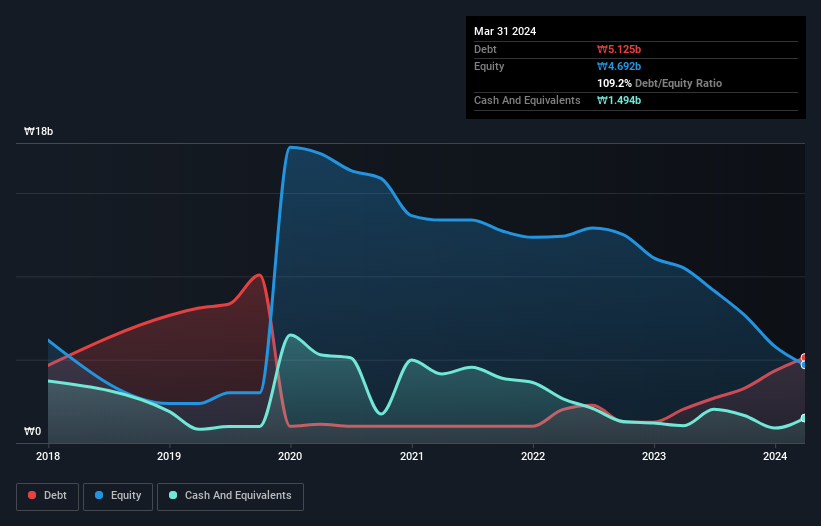- South Korea
- /
- Entertainment
- /
- KOSDAQ:A317530
Does Carriesoft (KOSDAQ:317530) Have A Healthy Balance Sheet?
Some say volatility, rather than debt, is the best way to think about risk as an investor, but Warren Buffett famously said that 'Volatility is far from synonymous with risk.' So it seems the smart money knows that debt - which is usually involved in bankruptcies - is a very important factor, when you assess how risky a company is. We can see that Carriesoft Co., Ltd. (KOSDAQ:317530) does use debt in its business. But should shareholders be worried about its use of debt?
Why Does Debt Bring Risk?
Debt assists a business until the business has trouble paying it off, either with new capital or with free cash flow. Ultimately, if the company can't fulfill its legal obligations to repay debt, shareholders could walk away with nothing. While that is not too common, we often do see indebted companies permanently diluting shareholders because lenders force them to raise capital at a distressed price. Of course, plenty of companies use debt to fund growth, without any negative consequences. The first thing to do when considering how much debt a business uses is to look at its cash and debt together.
See our latest analysis for Carriesoft
How Much Debt Does Carriesoft Carry?
The image below, which you can click on for greater detail, shows that at March 2024 Carriesoft had debt of ₩5.13b, up from ₩2.03b in one year. On the flip side, it has ₩1.49b in cash leading to net debt of about ₩3.63b.

How Healthy Is Carriesoft's Balance Sheet?
We can see from the most recent balance sheet that Carriesoft had liabilities of ₩7.57b falling due within a year, and liabilities of ₩769.1m due beyond that. Offsetting these obligations, it had cash of ₩1.49b as well as receivables valued at ₩1.00b due within 12 months. So its liabilities total ₩5.84b more than the combination of its cash and short-term receivables.
Carriesoft has a market capitalization of ₩28.3b, so it could very likely raise cash to ameliorate its balance sheet, if the need arose. But we definitely want to keep our eyes open to indications that its debt is bringing too much risk. The balance sheet is clearly the area to focus on when you are analysing debt. But you can't view debt in total isolation; since Carriesoft will need earnings to service that debt. So when considering debt, it's definitely worth looking at the earnings trend. Click here for an interactive snapshot.
In the last year Carriesoft had a loss before interest and tax, and actually shrunk its revenue by 34%, to ₩6.8b. To be frank that doesn't bode well.
Caveat Emptor
Not only did Carriesoft's revenue slip over the last twelve months, but it also produced negative earnings before interest and tax (EBIT). Indeed, it lost a very considerable ₩4.5b at the EBIT level. Considering that alongside the liabilities mentioned above does not give us much confidence that company should be using so much debt. So we think its balance sheet is a little strained, though not beyond repair. Another cause for caution is that is bled ₩2.2b in negative free cash flow over the last twelve months. So suffice it to say we consider the stock very risky. When analysing debt levels, the balance sheet is the obvious place to start. But ultimately, every company can contain risks that exist outside of the balance sheet. We've identified 5 warning signs with Carriesoft (at least 3 which can't be ignored) , and understanding them should be part of your investment process.
If you're interested in investing in businesses that can grow profits without the burden of debt, then check out this free list of growing businesses that have net cash on the balance sheet.
New: AI Stock Screener & Alerts
Our new AI Stock Screener scans the market every day to uncover opportunities.
• Dividend Powerhouses (3%+ Yield)
• Undervalued Small Caps with Insider Buying
• High growth Tech and AI Companies
Or build your own from over 50 metrics.
Have feedback on this article? Concerned about the content? Get in touch with us directly. Alternatively, email editorial-team (at) simplywallst.com.
This article by Simply Wall St is general in nature. We provide commentary based on historical data and analyst forecasts only using an unbiased methodology and our articles are not intended to be financial advice. It does not constitute a recommendation to buy or sell any stock, and does not take account of your objectives, or your financial situation. We aim to bring you long-term focused analysis driven by fundamental data. Note that our analysis may not factor in the latest price-sensitive company announcements or qualitative material. Simply Wall St has no position in any stocks mentioned.
Have feedback on this article? Concerned about the content? Get in touch with us directly. Alternatively, email editorial-team@simplywallst.com
About KOSDAQ:A317530
Carriesoft
Carriesoft Co., Ltd. creates and publishes contents for kids and family worldwide.
Moderate risk with worrying balance sheet.
Market Insights
Community Narratives



